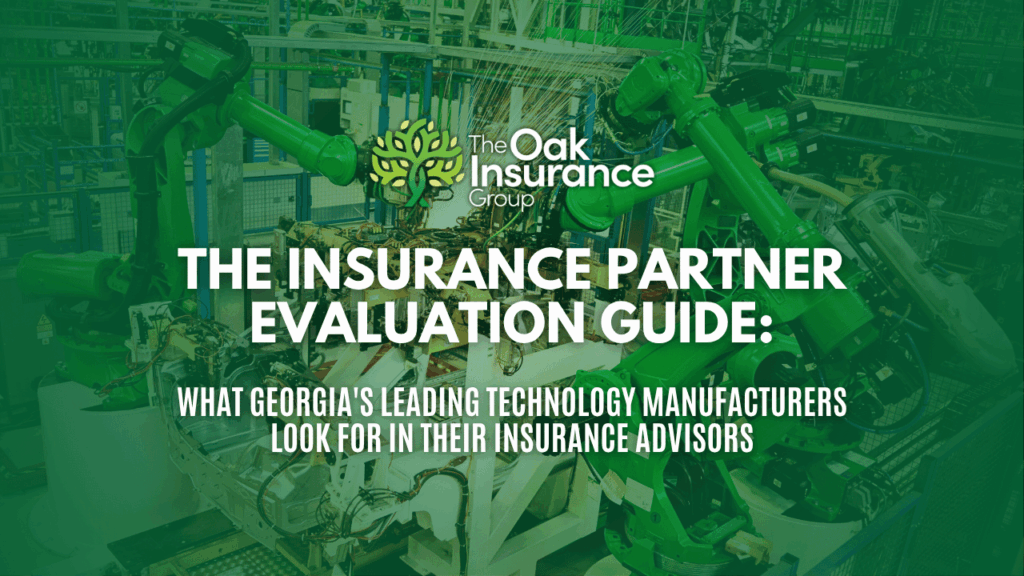
How Georgia Tech Manufacturers Choose the Right Insurance Partner
Georgia’s technology manufacturing industry is one of the most advanced and fast-moving in the country. Whether building aerospace components, medical devices, or cutting-edge electronics, these companies are constantly innovating. But with innovation comes complexity—and a growing web of operational, legal, and reputational risks.
Many tech manufacturers rely on outdated or generic insurance policies that don’t match their exposure or growth ambitions. Worse, they may not realize they’re underprotected until a major incident proves it. That’s why more Georgia-based manufacturers are reevaluating what it really means to have the right insurance advisor by their side.
This article outlines the exact traits successful manufacturers look for when choosing an insurance partner who doesn’t just manage risk, but actively contributes to innovation, continuity, and long-term resilience.
Deep Industry Knowledge Isn’t Optional — It’s Foundational
If your advisor doesn’t understand your environment, they can’t protect it. Tech manufacturers work within specialized systems, processes, and regulations. A generalist agent or broker is simply not equipped to advise on your level.
Understanding Tech-Specific Risk Profiles
Your advisor should be fluent in:
- Product liability for first-of-its-kind innovations
- Cyber liability, data breaches, and ransomware threats
- IP infringement exposures and legal protections
- Rapid tech obsolescence and its insurance implications
These aren’t theoretical threats — they’re real scenarios with real costs, and you deserve guidance that reflects that.
Navigating Regulatory Complexity
With laws like the Georgia Manufacturing Data Protection Act (MDPA) and federal oversight increasing, regulatory missteps can cost millions. The right advisor stays current with:
- Manufacturing-specific data and privacy laws
- Insurance compliance tied to tax incentives and certifications
- Audit-proof documentation strategies
If they aren’t talking compliance during your review, it’s a red flag.
Experience with Advanced Systems
Modern manufacturers rely on robotics, automation, additive manufacturing, and global supply chains. Your advisor must be able to:
- Assess automation and equipment failure risks
- Advise on production line dependencies
- Help you plan for international disruptions and recall scenarios
You’re not just insuring a building — you’re protecting a high-performance machine of interconnected systems.
A Proactive Approach to Risk Makes All the Difference
Some advisors wait for problems before taking action. The right ones help you prevent them in the first place. Great partners don’t sell policies — they design dynamic risk strategies based on your evolving business.
Operational Risk Evaluation Across the Enterprise
Top advisors dig deep into your operations and ask questions like:
- Where are the gaps between current coverage and emerging risks?
- How will your upcoming product launch affect your liability profile?
- Are you prepared for both regulatory and market shifts?
Risk assessments aren’t a one-and-done checklist. They should happen regularly and be tied to your business roadmap.
Insurance That Moves With You
Your insurance portfolio should evolve alongside your tech stack and your market share. That means:
- Tailoring programs to geography, IP value, and revenue forecasts
- Reassessing coverage as your workforce grows or diversifies
- Offering flexibility as you expand internationally or adopt new tech
Rigid policies can stunt innovation. A great advisor builds in agility.
Treating Insurance as a Strategic Lever
When viewed correctly, your insurance program should:
- Improve investor confidence
- Shorten recovery time after incidents
- Fuel innovation by managing downside risk
That’s not overhead — that’s return on investment. And your advisor should help prove it.
Going Beyond Policies: A Broader Risk Ecosystem
Forward-thinking advisors may also bring:
- Predictive analytics platforms for risk modeling
- HR tools for reducing employment practices liability
- Business continuity plans tailored to your real operations
The relationship should be part of a larger value chain — not just a line item.
The Human Side of a Strong Insurance Partnership
Risk management is personal. You need an advisor who shows up — not just in emergencies, but as a consistent presence invested in your goals.
Clear, Frequent, and Transparent Communication
A great partner communicates in ways that build confidence:
- Regular check-ins with proactive insights
- Updates on legislative and market changes
- Clear breakdowns of renewals and claims impact
Silence is costly. You deserve responsiveness and visibility.
Shared Values and Strategic Alignment
The best partnerships are based on mutual understanding. Look for an advisor who:
- Understands your mission and values
- Speaks the language of manufacturing and innovation
- Operates with urgency, precision, and purpose
When you align culturally, everything else works better.
Always-On Accessibility
In tech manufacturing, downtime is money. You need an advisor who:
- Is reachable outside of standard hours
- Moves quickly when urgent adjustments are needed
- Responds like a partner — not a vendor
They’re not there just for renewals. They’re there for the moments that matter.
Focused on the Long Game
Look for signs that your advisor is playing the long game:
- Regular coverage reviews tied to business shifts
- Suggestions for optimizing your risk spend
- Strategic foresight as new risks emerge
The right partner grows with you. They’ll help you anticipate — not just react.
The Insurance Partner You Choose Today Will Shape Your Tomorrow
Choosing an insurance partner is not just a financial decision — it’s a strategic one. As a Georgia tech manufacturer, your risk profile is more complex than most, and your advisor needs to meet that complexity head-on.
Now that you know what to look for — deep expertise, strategic thinking, and a values-aligned approach — it’s time to take action. Evaluating your current partner with these criteria can uncover gaps you didn’t realize existed.
If you’re ready to audit your risk landscape and align your coverage with your growth strategy, your next step is clear:

